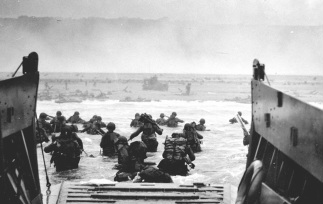 U.S. troops storm Omaha Beach
U.S. troops storm Omaha Beach On June 6, 1944, Allied troops stormed the beaches of Normandy in what might arguably be called the turning point of World War II.
The operation was huge. Some 5,000 vessels, 11,000 aircraft, and 150,000 personnel came across the English Channel on that day. Approximately 100,000 of those personnel were soldiers or marines. By the end of the day, 9,000 of them were killed or wounded.
While no one knew the exact location or date it was to occur, the invasion was not unexpected. The Germans began fortifying the coast of France in 1942. This construction was part of what was known as The Atlantic Wall, a series of fortifications stretching from Northern Norway to the Spanish border. Under Field Marshal Erwin Rommel's direction, thousands of forced laborers from Poland, France and other conquered countries were impressed into service constructing a series of steel reinforced concrete pillboxes. Six million mines were laid on the beaches and fields of Northern France. Fields that looked like possible landing sites for paratroopers were flooded or planted with sharpened poles, which Germans called Rommelspargel (Rommel's asparagus).
The Allies made sure to keep the Germans guessing as to where the invasion was going to come. The fleet of rubber ships and plywood tanks on display near Dover, across from Pas-de-Calais, at the narrowest point between France and England, fooled many Germans into believing that the invasion was going to come here. Others believed that the invasion was going to occur in Norway.
But it came in Normandy, and for a while the eyes of the whole world were focused there.
For more information on D-Day, including video and newsreels, click here.

